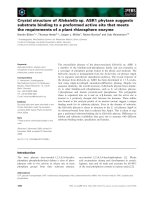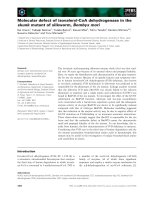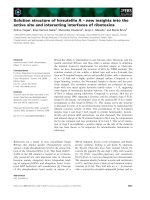Báo cáo khoa học: "Intramucosal leiomyosarcoma of the stomach following hereditary retinoblastoma in childhood – a case report and review of the literature" doc
Bạn đang xem bản rút gọn của tài liệu. Xem và tải ngay bản đầy đủ của tài liệu tại đây (391.88 KB, 5 trang )
BioMed Central
Page 1 of 5
(page number not for citation purposes)
World Journal of Surgical Oncology
Open Access
Case report
Intramucosal leiomyosarcoma of the stomach following hereditary
retinoblastoma in childhood – a case report and review of the
literature
Ursula Pauser*
1
and Horst Grimm
2
Address:
1
Department of Pathology, University of Lübeck, Lübeck, Germany and
2
Department of Endoscopic Surgery, University of Kiel, Kiel,
Germany
Email: Ursula Pauser* - ; Horst Grimm -
* Corresponding author
Abstract
Background: Leiomyosarcomas of the stomach are very rare. At the time of primary diagnosis
the tumors are most often in advanced stage and the patients complain of abdominal pain due to
large tumor size. Endosonographically, the tumors impress as submucous mass with suspicion to
malignancy. Sarcomas following hereditary retinoblastoma in childhood are in generally located in
the soft tissue. Structural alterations of the retinoblastoma gene (RB1) seem to be involved in the
pathogenesis.
Case presentation: A 37-year-old german male suffered from reflux disorder. In endoscopic
examination a small polypous tumor was detected in the stomach. The resection specimen revealed
an intramucosal leiomyosarcoma. At the age of one year, the patient had a retinoblastoma.
Conclusion: This is the unique report of an intramucosal gastric leiomyosarcoma and the first
account of a gastric leiomyosarcoma after retinoblastoma in childhood. A careful clinical follow-up
is advised because of increased risk of developing further metachronous malignancies.
Background
Leiomyosarcomas are of smooth muscle origin and
develop in the soft tissue of the vessel wall and in the
smooth muscle layer of visceral organs. In the gastrointes-
tinal tract, they normally arise in the submucosa and
bulge out the mucosa and serosa. They present most often
in advanced tumor stage. In this case we report of an intra-
mucosal gastric leiomyosarcoma. Medical history referred
treatment of a retinoblastoma in childhood. Sarcomas fol-
lowing hereditary retinoblastoma are in generally located
in the soft tissue. Structural alterations of RB1 seem to be
involved in the pathogenesis of the secondary malignancy
after treatment of retinoblastoma.
Case presentation
A 37-year-old man with reflux symptomatic was sent to
endoscopic examination. During the examination strabis-
mus was striking. The patient reported about eye opera-
tion with 1 year of age, due to a retinoblastoma. Both eyes
were affected. The right eye was enucleated. The left eye
was treated with laser. There was no tumor relapse. A
germline mutation in RB1 was detected in 1988. In family
history there is no further case of retinoblastoma. Due to
tumor prevention the patient underwent endoscopic
examination. In gastroscopy, a 1 cm in diameter polypous
lesion was found in the antrum of the stomach. It was sus-
picious to be a hyperplastic polyp or an adenoma of gas-
Published: 14 December 2008
World Journal of Surgical Oncology 2008, 6:131 doi:10.1186/1477-7819-6-131
Received: 26 May 2008
Accepted: 14 December 2008
This article is available from: />© 2008 Pauser and Grimm; licensee BioMed Central Ltd.
This is an Open Access article distributed under the terms of the Creative Commons Attribution License ( />),
which permits unrestricted use, distribution, and reproduction in any medium, provided the original work is properly cited.
World Journal of Surgical Oncology 2008, 6:131 />Page 2 of 5
(page number not for citation purposes)
tric mucosa. The polypous lesion was resected
endoscopically and was sent to histopathological investi-
gation. Representative 4 μm sections of formalin-fixed,
paraffin-embedded tissue from the tumor specimens were
stained with hematoxylin and eosin (H&E) and periodic
acid-Schiff. Immunohistochemical staining was per-
formed using the standard avidin-biotin method with
antibodies against smooth muscle actin (SMA, 1:20, Dako
Cytomation, Glostrup, Denmark), S100 (1:500, Dako
Cytomation), CD34 (1:500, Immunotech, Marseille,
France) and KIT (1:50, Dako Cytomation). The prolifera-
tive activity was assessed by staining the tissue with the
antibody MiB-1 (1:100, Dako Cytomation).
The polypous lesion, 1 cm in diameter, showed regular
foveolar gastric glands and a diffuse spindle cell infiltrate
in the mucosa. The spindle cells were arranged in parallel
and whorl like bundles. The nuclei were elongated with
plump ends and focally mild atypia (Fig. 1). There was an
increased mitotic rate with 20 mitotic figures in 50 high
power fields. In the immunoassay, the tumor cells stained
strongly positive for SMA (Fig. 2) and negative for KIT,
CD34, and S100. The proliferative activity, identified by
MiB-1, was approximately 20% (Fig. 3). The spindle cell
infiltrate was classified as an unusual intramucosal leio-
myosarcoma of low grade malignancy. The diagnosis was
confirmed by a referee pathologist. The tumor achieved
the resection mark of the biopsy focally. In endosono-
graphic monitoring 4 weeks later, there was no tumor
residuum observed. Because of tumor malignancy, muco-
sectomy followed. The biopsy revealed a scar next to reg-
ular mucosa and lamina muscularis mucosae. Tumor
residuum was not seen. In the literature were neither data
of tumor treatment nor data with long time follow-up of
intramucosal leiomyosarcoma available. The clinical out-
come was not predictable. According to an expert of the
Tumor infiltrate with spindle cells arranged in parallel bundlesFigure 1
Tumor infiltrate with spindle cells arranged in parallel bundles. The nuclei were elongated with plump ends and
focally mild atypia. Several mitoses are shown (HE, original magnification × 400).
World Journal of Surgical Oncology 2008, 6:131 />Page 3 of 5
(page number not for citation purposes)
European Sarcoma Study Group, a limited resection of the
gastric antrum was recommended and done 4 weeks later.
Reexamination revealed a chronic gastritis and a scar after
mucosectomy, but no tumor residuum. Perigastric lymph
nodes and a paracaval lymph node were free of tumor. A
R0-resection with high safety of the resection margin was
achieved. The endoscopic and endosonographic follow-
up was inconspicuous since 3 years.
Discussion
Leiomyosarcomas of the stomach are rare. They usually
present in older age and are typically of high grade malig-
nancy (WHO 2000). They arise from the smooth muscle
of gastric wall and were mostly located in the submucosa.
The histological diagnosis of a leiomyosarcoma is une-
quivocal on the basis of the immunohistochemical
expression of SMA. At the time of primary diagnosis the
tumor size is normally large. Complete tumor resection is
the standard treatment. The reported case was exception-
ally, clinical and histological. The leiomyosarcoma resem-
bled a polyp of the gastric mucosa without criteria of a
stromal tumor or signs of malignancy. The tumor was lim-
ited to the mucosa, showed mild nuclear atypia but a high
proliferative activity. It is the unique intramucosal leiomy-
osarcoma of the stomach and the first gastric leiomyosar-
coma described in a survivor of a retinoblastoma in
childhood. Because of the young age of the patient, the
high proliferative activity of the tumor and the visceral
tumor site, a resection with large tumor free margins was
striving. There is an increased risk for the development of
a metachronous malignancy following hereditary retino-
blastoma due to the prior treatment and/or genetic sus-
ceptibility of RB1 [1,2]. Alterations in RB1 are thoroughly
investigated in soft tissue tumors [3]. Most often are oste-
Immunohistochemical staining highlight the diffuse spindle cell infiltrate in the gastric mucosaFigure 2
Immunohistochemical staining highlight the diffuse spindle cell infiltrate in the gastric mucosa. The tumor infil-
trates the stroma between regular differentiated gastric glands. The tumor cells stain strongly positive for SMA. The preexist-
ing gastric glands are negative (SMA, original magnification × 100).
World Journal of Surgical Oncology 2008, 6:131 />Page 4 of 5
(page number not for citation purposes)
osarcomas, followed by soft tissue sarcomas. One study
reported about three patients with leiomyosarcoma of the
soft tissue, in the radiation field of a primary malignancy
in childhood, 11 to 13 years earlier [1]. A leiomyosarcoma
of the liver was detected in a 39-year-old woman, who has
been treated 37 years before, for hereditary retinoblast-
oma of the eye [4]. A leiomyosarcoma in the maxillofacial
region, followed by a chorioncarcinoma 5 years later, was
described in a long-term follow up after treatment of a
bilateral retinoblastoma [5]. Visceral leiomyosarcoma of
the urinary bladder is reported in two cases, 38 years and
47 years after hereditary retinoblastoma [6,7]. The
patients had a tumor free survival of about 3 decades
between retinoblastoma and second malignancies. This is
in common with our case. Similar results were reported in
a large cohort of retinoblastoma patients recently [2].
However, 15 out of 23 leiomyosarcoma occurred outside
the radiation field of retinoblastoma. Most frequently
were uterine leiomyosarcoma. It seems unlikely that the
radiation exposure caused the leiomyosarcoma. Moreover
a radiation – induced chromosome instability of single
normal RB1 copy seems to be involved in tumor develop-
ment. Radiation combined with chemotherapy was asso-
ciated with a heightened risk for leiomyosarcoma in this
study.
Since neither radiation nor chemotherapy treatment is
reported in our case, primary genetic alterations, i.e. in
RB1 may have a protooncogenetic effect on the develop-
ment of secondary malignancies. As described earlier
there is an increased risk to develop a third tumor.
Conclusion
This is the unique report of an intramucosal gastric leio-
myosarcoma and the first account of a gastric leiomyosar-
coma after retinoblastoma in childhood. A careful clinical
The proliferative activity of the tumor infiltrate, identified by MiB-1, is approximately 20%Figure 3
The proliferative activity of the tumor infiltrate, identified by MiB-1, is approximately 20%. There is a normal pro-
liferative activity of epithelial cells in the bottom of foveolar gastric glands (MIB-1, original magnification × 100).
Publish with BioMed Central and every
scientist can read your work free of charge
"BioMed Central will be the most significant development for
disseminating the results of biomedical research in our lifetime."
Sir Paul Nurse, Cancer Research UK
Your research papers will be:
available free of charge to the entire biomedical community
peer reviewed and published immediately upon acceptance
cited in PubMed and archived on PubMed Central
yours — you keep the copyright
Submit your manuscript here:
/>BioMedcentral
World Journal of Surgical Oncology 2008, 6:131 />Page 5 of 5
(page number not for citation purposes)
follow-up is advised because of increased risk of develop-
ing further metachronous malignancies.
Consent
Written informed consent was obtained from the patient
for publication of this case report and accompanying
images. A copy of the written consent is available for
review by the Editor-in-Chief of this journal.
Competing interests
The authors declare that they have no competing interests.
Authors' contributions
UP drafted the manuscript with review of the literature
and took the microscopic imaging.
HG participated in the care of the patient, contributed the
clinical data and revised the manuscript for intellectual
content and given final approval of the version to be pub-
lished.
Both of the authors read and approved the final manu-
script.
References
1. Bisogno G, Sotti G, Nowicki Y, Ferrari A, Garaventa A, Zanetti I,
Favre C, Schiavetti A, Tamaro P, Carli M: Soft tissue sarcoma as a
second malignant neoplasm in the pediatric age group. Can-
cer 2004, 100:1758-1765.
2. Kleinerman RA, Tucker MA, Abramson DH, Seddon JM, Tarone RE,
Fraumeni JF Jr: Risk of soft tissue sarcomas by individual sub-
type in survivors of hereditary retinoblastoma. J Natl Cancer
Inst 2007, 99:24-31.
3. Stratton MR, Williams S, Fisher C, Ball A, Westbury G, Gusterson BA,
Fletcher CD, Knight JC, Fung YK, Reeves BR: Structural altera-
tions of the RB1 gene in human soft tissue tumours. Br J Can-
cer 1989, 60:202-205.
4. Abdelli N, Thiefin G, Diebold MD, Bouche O, Aucouturier JP, Zeitoun
P: Primary leiomyosarcoma of the liver 37 years after suc-
cessful treatment of hereditary retinoblastoma. Gastroenterol
Clin Biol 1996, 20:502-505.
5. Marta U, Zsuzsanna S, Jozsef B, Zsolt N, Bela S, Gyorgy S: Rare inci-
dence of three consecutive primary tumors in the maxillofa-
cial region: retinoblastoma, leiomyosarcoma, and
choriocarcinoma: case report. J Craniofac Surg 2001, 12:464-468.
6. Liang SX, Lakshmanan Y, Woda BA, Jiang Z: A high-grade primary
leiomyosarcoma of the bladder in a survivor of retinoblast-
oma. Arch Pathol Lab Med 2001, 125(9):1231-1234.
7. Venkatraman L, Goepel JR, Steele K, Dobbs SP, Lyness RW, McClug-
gage WG: Soft tissue, pelvic, and urinary bladder leiomyosar-
coma as second neoplasm following hereditary
retinoblastoma. J Clin Pathol 2003, 56:233-236.









